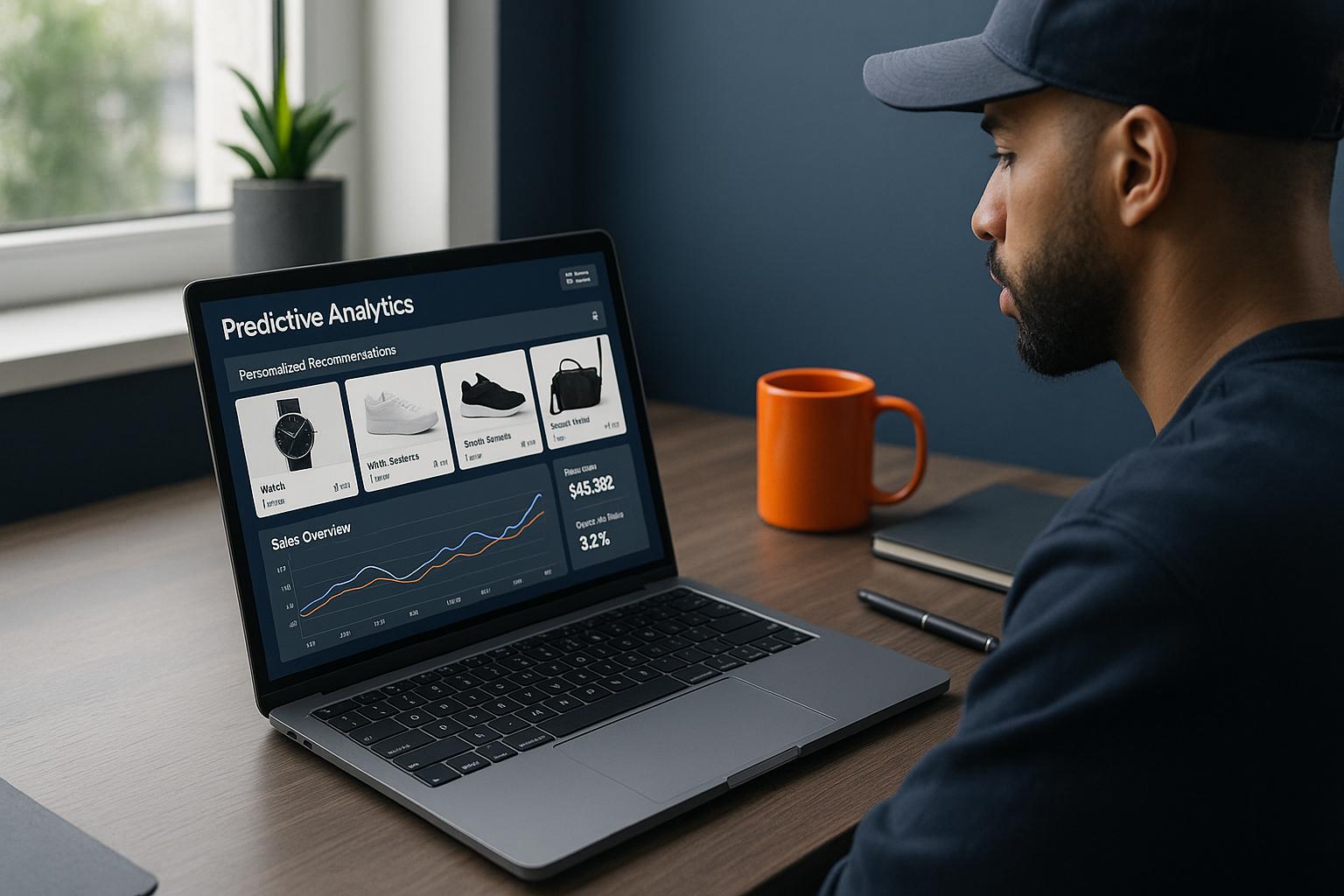Analyzing competitor data can give you a clear edge in your marketing strategy. By understanding their strengths, weaknesses, and customer feedback, you can build campaigns that directly address market gaps and unmet needs. Here’s how:
- What to Analyze: Reviews, social media, search rankings, industry reports, and news.
- Tools to Use: Sentiment analysis, SWOT frameworks, benchmarking, and content analysis.
- What to Look For: Patterns in customer complaints, gaps in service, pricing transparency issues, and overlooked customer needs.
- How to Act: Craft messages that solve frustrations, create offers tailored to specific groups, and focus on areas competitors fail.
- Measure Success: Track ROI, conversion rates, CAC, and engagement to refine your approach.
Competitor insights aren’t just data – they’re a roadmap to smarter, more focused campaigns.
Competitive analysis made simple: 7 steps to smarter strategy
How to Collect and Analyze Competitor Reputation Data
Understanding your competitors is a powerful way to refine your strategy. The process starts by gathering data about your competitors and then analyzing it to uncover actionable insights. Here’s how to do it effectively.
Where to Find Competitor Reputation Data
Online review platforms are a goldmine for understanding how customers perceive your competitors. Websites like Google Reviews, Yelp, Trustpilot, and industry-specific platforms showcase customer opinions about products and services. Look for recurring themes that highlight strengths or expose weaknesses.
Social media channels provide a real-time window into customer interactions with competitor brands. Dive into their Facebook pages, Twitter mentions, Instagram comments, and LinkedIn posts. Pay attention to engagement levels, how quickly they respond, and the tone of those conversations. Social listening tools can simplify tracking mentions across multiple platforms. These channels also reveal how competitors handle customer service, from resolution times to overall satisfaction.
Search engine results offer clues about competitors’ reputations. Analyze their search rankings for key industry terms, featured snippets, and Google My Business profiles. Negative search results – or their absence – on the first page can indicate how well they manage their online reputation.
Industry reports and market research from firms like Forrester, Gartner, or IBISWorld provide professional evaluations of competitors. These reports often include data on customer satisfaction, market share, and competitive positioning. Access them through business databases or directly from the research firms.
News coverage and press releases reveal how competitors present themselves publicly and how they’re viewed in the media. Use Google Alerts to stay updated on mentions of competitor names. Trade publications often provide deeper insights into industry players, offering perspectives that general news sources might miss.
Tools and Methods for Analyzing the Data
Sentiment analysis tools can process large amounts of text from reviews and social media posts to gauge overall sentiment. These tools also pinpoint specific topics that spark strong reactions, both positive and negative.
SWOT analysis frameworks help organize your findings into categories: strengths, weaknesses, opportunities, and threats. This structured approach pushes you to go beyond surface observations and consider the strategic implications of your data.
Data verification techniques ensure your conclusions are based on credible information. Cross-check patterns you notice in reviews with mentions in news articles or social media discussions. Be cautious of fake reviews or coordinated campaigns that could distort your analysis.
Competitive benchmarking and trend analysis allow you to compare competitors using standardized metrics. Develop a scoring system for factors like customer service, product features, pricing, and brand perception. Track these metrics regularly – monthly or quarterly – to identify changes in reputation over time.
Content analysis focuses on the messaging competitors use in their marketing. Study their website copy, ad campaigns, and social media posts to understand how they position themselves. This can reveal their priorities and how they aim to appeal to their audience.
The objective isn’t just to collect data but to transform it into clear insights about market positioning, customer preferences, and competitive advantages. By combining multiple data sources and analysis techniques, you can build a detailed picture of the competitive landscape.
How to Turn Competitor Data into Useful Insights
Turning competitor data into insights that actually influence your marketing strategy is all about spotting patterns, identifying opportunities, and organizing what you find in a way that drives decisions. By analyzing both their strengths and weaknesses, you can uncover gaps in the market and refine your approach.
Finding What Competitors Do Well and Poorly
Spot patterns to uncover useful insights. Look for recurring themes across reviews, social media, and other data sources. For example, repeated complaints can highlight genuine weaknesses, while consistent praise can point to areas where competitors excel.
Identify customer pain points by systematically analyzing negative feedback. Recurring issues – whether related to service, product features, or communication – can reveal opportunities for your brand to step in as the solution.
Learn from successful strategies. When competitors receive consistent praise for certain tactics, it’s worth taking note. This isn’t about copying – it’s about understanding what works and adapting it to fit your brand’s unique strengths.
Examine how competitors respond to feedback. Companies that handle negative reviews with speed and professionalism often maintain better reputations. On the flip side, those that ignore or respond poorly to criticism tend to see their ratings suffer. This can guide your own approach to reputation management.
Analyze timing trends. Pay attention to when competitors face challenges, such as seasonal dips in reviews or slower response times during major launches. These patterns can help you time your campaigns for maximum impact.
By understanding what competitors do well and where they fall short, you can position your brand to stand out.
Finding Market Gaps and Opportunities
Competitor oversights often reveal opportunities for your brand to shine.
Look for unmet customer needs. Feedback often reveals what people wish competitors offered but don’t. Use this to highlight how your brand fills these gaps.
Spot service delivery gaps. Compare what competitors promise with what their customers actually experience. If there’s a mismatch, you can position your brand as more dependable or transparent.
Tailor your communication. Competitors often adopt a one-size-fits-all approach, missing the nuances of different customer preferences. Whether it’s offering detailed technical explanations or simplified messaging, you can connect with underserved segments by speaking their language.
Address geographic or demographic blind spots. If competitors struggle to connect with specific regions or groups, it’s a chance for you to step in with targeted campaigns.
Tackle price-value perception issues. If customers frequently mention that competitors are overpriced or unclear about their pricing, this is an opportunity for your brand to emphasize better value or transparency.
Creating a Comparison Table for Clear Analysis
A comparison table can help you organize your findings and identify actionable opportunities.
Key categories to include might be customer satisfaction, response times, pricing clarity, service quality, and brand trust. These metrics provide a clear picture of how competitors stack up.
Use a consistent scoring system. A 1-to-5 scale based on quantifiable data like average ratings or sentiment scores ensures objectivity.
Spot opportunities visually. A table makes it easier to see where competitors are weak or strong. For instance, if all competitors score poorly in a category, it signals a market-wide gap your brand can address.
| Reputation Factor | Competitor A | Competitor B | Competitor C | Market Opportunity |
|---|---|---|---|---|
| Customer Service Response | 3.2/5 | 4.1/5 | 2.8/5 | Moderate – B leads |
| Pricing Transparency | 2.1/5 | 2.4/5 | 2.0/5 | High – All struggle |
| Product Quality | 4.2/5 | 3.8/5 | 4.0/5 | Low – Market satisfied |
| Communication Clarity | 2.9/5 | 3.1/5 | 2.7/5 | High – All underperform |
Monitor trends over time. Update your table regularly – monthly or quarterly – to track changes in competitor performance. These shifts can signal new opportunities or threats.
Turn insights into action. Use the table to guide your campaigns. For example, if competitors perform poorly in pricing transparency, emphasize your brand’s clear and fair pricing in your messaging.
sbb-itb-d6d4d8b
How to Customize Campaigns Using Competitor Insights
Leverage competitor data to craft campaigns that truly connect with your audience. By addressing gaps and preferences revealed through your analysis, you can create messages, offers, and strategies that stand out. This approach ensures your campaigns are tailored and impactful.
Creating Messages That Address Market Needs
Your messaging should directly tackle the weaknesses and missed opportunities you’ve uncovered in your competitor analysis. For instance, if customers often complain about poor communication from competitors, make clear and straightforward communication the centerpiece of your campaigns. Similarly, if pricing transparency is a common issue, highlight your pricing upfront.
Focus on solving customer frustrations. If competitors are known for slow response times, use headlines like "Get answers in under 2 hours" or "No waiting, no hassle." This directly contrasts their shortcomings without explicitly naming them.
When your analysis shows competitors falling short in a specific area, seize the opportunity to excel there. For example, if customer service is a weak spot across the industry, build campaigns around your superior support, making it a key differentiator.
Speak the customer’s language. If reviews frequently use words like "confusing" or "hard to reach" to describe competitors, incorporate terms like "simple" and "always available" into your messaging. This creates an instant connection with customers who are already frustrated.
Test different messages to see what resonates most. Run campaigns emphasizing speed, transparency, or clarity, depending on the gaps you’ve identified. Monitor their performance to determine which approach best connects with your audience.
Personalizing Offers and Content Plans
Competitor insights don’t just reveal what customers dislike – they also highlight what different audience segments value most. Use this information to craft targeted offers that address unmet needs.
If specific groups, like small business owners or enterprise clients, frequently express frustration with competitors, create campaigns tailored to their concerns. For example, small businesses might appreciate simplified pricing, while enterprise clients value better account management.
Fill the information gaps competitors leave. If reviews show customers asking questions competitors fail to address, create content that answers them. For instance, if implementation timelines are a common concern, develop guides or case studies that clearly outline your process.
Offer solutions to common competitor shortcomings. If competitors charge hidden fees, emphasize your transparent pricing. If long-term contracts are unpopular, highlight flexible month-to-month options. Your offers should feel like the exact solution customers have been searching for.
Adapt to the customer journey. Competitor data often reveals where customers get stuck during the buying process. Use this insight to create targeted content and offers for those specific stages, helping prospects move forward more easily.
Plan strategically for peak times. If competitors struggle during busy seasons or product launches, schedule campaigns that highlight your reliability during those critical moments. This proactive approach can help you win over customers when they’re most dissatisfied with the alternatives.
Building Data-Based Customer Profiles for Better Targeting
Competitor insights are a goldmine for refining your customer segmentation. By analyzing customer preferences, behaviors, and feedback, you can develop detailed profiles that improve your targeting.
Spot distinct customer segments. Look for patterns in feedback – who complains about what, who praises certain features, and who frequently switches providers. These trends reveal different customer types with unique priorities and pain points.
Match customer preferences to competitor feedback. For example, if younger customers rave about mobile apps while older ones value phone support, tailor your messaging and channels accordingly.
Understand what drives decisions. Some customers care most about price, while others prioritize features or service quality. Competitor reviews can help you identify these preferences and adjust your targeting to align with what matters most to each group.
Build behavioral profiles. Notice which customers leave detailed reviews, switch providers often, or stay loyal despite issues. These behaviors indicate varying levels of engagement and help you fine-tune your marketing approach.
Identify geographic and demographic trends. If competitors consistently struggle in certain regions or with specific age groups, target these underserved segments with campaigns that address their specific concerns.
Go beyond basic demographics when building customer profiles. Include details like preferred communication styles, key decision factors, common objections, and the competitor experiences that led them to seek alternatives. This level of personalization allows you to create campaigns that feel relevant and relatable, boosting both engagement and conversions.
Measuring Results and Improving Your Campaigns
Once your competitor-driven campaigns are live, it’s crucial to track the right metrics. These numbers don’t just show how well your campaign is doing – they also help confirm the value of using competitor insights to guide your strategy.
Key Metrics to Track Campaign Performance
Start with Return on Investment (ROI), which measures profitability by subtracting campaign costs from revenue, then dividing by those costs. Another vital metric is ROAS (Return on Ad Spend), which highlights how much revenue you earn for every dollar spent on ads. For instance, a 4:1 ratio means $4 in revenue for every $1 spent.
Conversion rates are another key indicator. They measure how well your campaign turns visitors into customers or leads, whether that’s through purchases, sign-ups, or other desired actions.
Keep an eye on Customer Acquisition Cost (CAC) to gauge how efficiently you’re gaining new customers. Pair this with Click-Through Rate (CTR) to see how compelling your messaging is in driving clicks.
Break down website traffic by source – whether it’s email, social media, organic search, or paid ads. This analysis helps you decide where to focus your budget for the best results.
Lastly, track engagement rates on social media. Metrics like likes, comments, shares, and reposts reveal how well your content resonates with your audience.
Use these metrics to guide ongoing adjustments and keep your campaigns on track.
Ongoing Monitoring and Campaign Improvements
Improving your campaigns is a continuous process, especially as competitors adjust their strategies. Review your performance metrics weekly to spot trends and react quickly. Keeping an eye on your competitors can also signal when it’s time to tweak your approach.
Set benchmarks based on your initial competitor analysis to measure progress. For example, a noticeable boost in conversion rates compared to your starting point indicates that your strategy is working. On the flip side, if results start slipping toward earlier levels, it might be time to rethink your tactics.
A/B testing is another powerful tool for fine-tuning your campaigns. Test different headlines, offers, and content variations to see what resonates most with your audience. Even small wins here can add up to significant results over time.
Automated alerts can help you stay on top of sudden changes. If conversion rates drop or customer acquisition costs spike, act quickly to figure out what’s going wrong. Document both your successes and challenges to refine your approach for future campaigns.
Using AI Tools for Long-Term Campaign Success
To make campaign management easier, consider using AI tools that integrate with your metrics. These tools can automate data analysis for key indicators like ROI, ROAS, conversion rates, and CAC, giving you a real-time snapshot of your campaign’s performance.
For example, platforms like JeffLizik.com offer AI-driven systems that analyze competitor data and provide tailored recommendations. These tools simplify the process, allowing you to focus on strategy while maintaining a competitive edge in your market.
Conclusion: Turning Competitor Data into Marketing Success
Using competitor reputation data to fine-tune your marketing campaigns is a smart way to stay ahead in today’s competitive landscape. Throughout this guide, we’ve covered how to gather meaningful insights, turn them into actionable strategies, and track the results that truly impact your business.
Begin by gathering competitor feedback from sources like review platforms, social media discussions, and industry forums. This raw data becomes incredibly useful when you analyze it for patterns – spotting strengths you can learn from and weaknesses you can exploit. These patterns are the foundation for creating impactful strategies.
Next, put these insights to work by focusing on three key areas: creating messages that address unmet needs in the market, tailoring your offers to fill gaps left by competitors, and building customer profiles based on actual preferences instead of assumptions.
To ensure your efforts are paying off, track metrics like ROI, ROAS, conversion rates, and customer acquisition costs. Regularly monitor your campaigns and use A/B testing to adapt quickly to shifting market conditions.
Once your campaigns show positive results, take it a step further by incorporating advanced tools. AI-powered solutions can automate competitor analysis and campaign adjustments, saving you time and helping you focus on the bigger picture. For example, platforms like JeffLizik.com provide AI-driven systems that analyze competitor data and deliver custom recommendations, allowing you to maintain a strong competitive edge.
The most successful companies don’t stop there – they treat competitor analysis as an ongoing process. By continuously collecting new data, experimenting with strategies, and refining campaigns based on real-time feedback, they turn competitor insights into a dynamic and effective marketing engine.
FAQs
How can I use competitor insights to find market gaps and unmet customer needs?
To uncover market gaps and unmet customer needs using insights from competitors, start by diving into their products, pricing strategies, and marketing approaches. Pay attention to areas where customer demands seem under-addressed or where competitors might be falling short. A SWOT analysis is a great tool for this – it helps you break down their strengths and weaknesses, which can reveal opportunities to bring something fresh to the table.
On top of that, market research is essential. Segment your audience and gather direct feedback to identify underserved groups or overlooked needs. By blending competitor insights with customer data, you can zero in on specific gaps your business can address. This not only helps you meet customer expectations but also gives you a chance to stand out in a crowded marketplace.
What are the most effective tools and methods for analyzing competitor reputation data?
To get a clear picture of your competitors’ reputation, you can rely on digital market intelligence tools and social listening platforms. Tools like SimilarWeb, Semrush, and Ahrefs offer a wealth of data on competitors’ market standing, SEO performance, and overall digital footprint. Meanwhile, platforms such as Sprout Social and Brandwatch let you monitor their social media activity and gauge customer sentiment toward their brand.
Key methods for analysis include SWOT analysis to pinpoint strengths, weaknesses, opportunities, and threats, as well as benchmarking and market share analysis for comparing performance metrics. By pulling data from online sources, social media interactions, and broader market research, these tools and techniques equip you to craft marketing strategies that are both audience-focused and informed by competitor insights.
How can I evaluate the success of marketing campaigns built using competitor insights?
To measure how well campaigns based on competitor insights perform, focus on key performance indicators (KPIs) that match your business objectives. Metrics like engagement rates, website traffic, conversions, and return on investment (ROI) are great for gauging how effectively your campaign resonates with your target audience.
You might also want to keep an eye on specific metrics such as click-through rates (CTR), customer acquisition costs (CAC), and overall revenue growth. These numbers give you a clear picture of your campaign’s effectiveness and show whether using competitor data is driving tangible results. By regularly reviewing these KPIs, you can ensure your marketing strategies stay on track and deliver meaningful outcomes.








